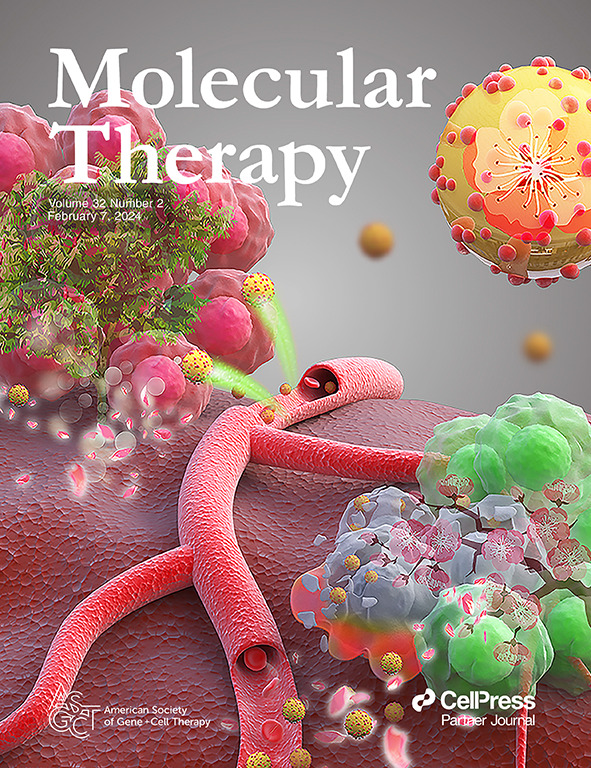锁定CBL TKBD的天然构象为突变型CBL依赖性白血病提供了新的治疗机会。
IF 12.1
1区 医学
Q1 BIOTECHNOLOGY & APPLIED MICROBIOLOGY
引用次数: 0
摘要
Casitas b系淋巴瘤(CBL)是一种E3泛素连接酶,对受体蛋白酪氨酸激酶(RTKs)的负调节至关重要。有害的CBL突变体失去E3活性,但作为接头获得功能,导致骨髓增生性肿瘤。目前,还没有针对CBL突变依赖性疾病患者的靶向治疗方法。通过结合噬菌体展示技术和基于结构的优化,我们发现了一种纳米摩尔亲和肽抑制剂CBLock,它可以结合CBL的酪氨酸激酶结合域(TKBD)的底物结合位点。CBLock破坏CBL突变体和rtk之间的相互作用,从而损害rtk介导的CBL突变体适配器功能的启动和下游信号传导。值得注意的是,CBLock结合TKBD而不引起构象变化,从而保持其无配体的天然构象。相反,当CBL与RTK底物结合时,TKBD会发生构象变化。在携带CBL突变的白血病细胞中,维持CBL TKBD的天然构象对于CBLock抑制增殖、诱导细胞周期阻滞和促进细胞凋亡至关重要。在急性髓性白血病(AML)小鼠异种移植模型中,CBLock减轻了肿瘤负荷,提高了生存率。此外,CBLock抑制来自CBL突变患者的细胞的增殖。因此,抑制CBL TKBD在其天然状态下为靶向突变型CBL依赖性白血病提供了一个有希望的治疗机会。本文章由计算机程序翻译,如有差异,请以英文原文为准。
Locking CBL TKBD in its native conformation presents a novel therapeutic opportunity in mutant CBL-dependent leukemia.
Casitas B-lineage lymphoma (CBL) is an E3 ubiquitin ligase critical for negatively regulating receptor protein tyrosine kinases (RTKs). Deleterious CBL mutants lose E3 activity, but act as adaptors that gain function to cause myeloproliferative neoplasms. Currently, there is no targeted treatment available for patients with CBL mutant-dependent disorders. By combining phage-display technology and structure-based optimization, we discovered CBLock, a nanomolar affinity peptide inhibitor, that binds the substrate-binding site of CBL's tyrosine kinase binding domain (TKBD). CBLock disrupts the interaction between CBL mutants and RTKs, thereby impairing RTK-mediated priming of adaptor function of CBL mutants and downstream signaling. Notably, CBLock binds TKBD without inducing conformational changes, thereby preserving its ligand-free native conformation. In contrast, when CBL binds RTK substrates, TKBD undergoes a conformational change. Maintaining the native CBL TKBD conformation was crucial for CBLock to inhibit proliferation, induce cell cycle arrest, and promote apoptosis in leukemia cells harboring CBL mutations. In a mouse xenograft model of acute myeloid leukemia (AML), CBLock reduced tumor burden and improved survival rate. Moreover, CBLock inhibited the proliferation of cells derived from patients with CBL mutations. Therefore, inhibiting CBL TKBD in its native state presents a promising therapeutic opportunity in targeting mutant CBL-dependent leukemia.
求助全文
通过发布文献求助,成功后即可免费获取论文全文。
去求助
来源期刊

Molecular Therapy
医学-生物工程与应用微生物
CiteScore
19.20
自引率
3.20%
发文量
357
审稿时长
3 months
期刊介绍:
Molecular Therapy is the leading journal for research in gene transfer, vector development, stem cell manipulation, and therapeutic interventions. It covers a broad spectrum of topics including genetic and acquired disease correction, vaccine development, pre-clinical validation, safety/efficacy studies, and clinical trials. With a focus on advancing genetics, medicine, and biotechnology, Molecular Therapy publishes peer-reviewed research, reviews, and commentaries to showcase the latest advancements in the field. With an impressive impact factor of 12.4 in 2022, it continues to attract top-tier contributions.
 求助内容:
求助内容: 应助结果提醒方式:
应助结果提醒方式:


